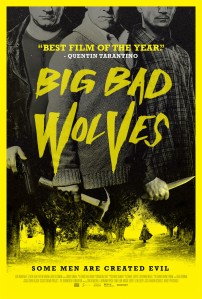Big Bad Wolves
It’s easy to see why Quentin Tarantino named Big Bad Wolves as the best film of 2013. It’s basically a love letter to the filmmaker’s earlier work – an elaboration on that infamous torture scene in Reservoir Dogs.
Filmmakers Aharon Keshales and Navot Papushado’s bottled thriller has three men (a father who’s daughter has been kidnapped and murdered, a renegade cop, and a tied up potential criminal) spar with one another to find the whereabouts of the daughter’s decapitated head. Oh, and to get violent revenge.
Keshales and Papushado want to pull off a layered film where characters are pushed to the limits and are forced to go places they didn’t expect to go to; thus, filling out the character development with unpredictable arcs.
Big Bad Wolves, however, only gives audiences the broad strokes of depravity, desperation, and deception. There’s nothing necessarily thought-provoking or cunning to the screenplay (also written by the directors) which plays out like a prepubescent teen’s idea of “cool” and “gritty”.
The subject matter involving kidnapped children and passionate angry adults is disturbing, but the directorial team doesn’t dig any deeper than your basic storyboard motivations.
Because there’s no emotional connection between the film and the paying public, Keshales and Papushado shovel violence into a scene in order to pull a jolting reaction from their audience. The effects are terribly graphic and the torture is so nasty, even the thirstiest of gore hounds will find Big Bad Wolves to be too sadistic.
If Keshales and Papushado had observed Tarantino’s work again, they may have caught on to the fact that the imaginative Academy Award winner prefers dialogue over visuals. They could’ve just as easily generated the same squirmy reception from their audience if the duo had just thought outside the box.
Films like Hard Candy and Tape have shown movie goers that it’s possible to create a bottle film that relies entirely on tension and imagination built by well crafted characterization and detailed rehearsal. Keshales and Papushado would much rather have bruised, bloodied flesh do all of the talking and sneering in Big Bad Wolves.
If I have any pats-on-the-backs for these two filmmakers, it’s that I was pleased to see that they were able to insert instances of dark comedy amidst the unpleasantries. There’s the occasional quippy conversation that happens between the brutality, but the dry sense of humour hardly feels tacked on in order to break the ice.
Nevertheless, I expected more maturity from Big Bad Wolves. I’d prefer to see thrillers turn up the heat in ways that ask the audience to use our heads – even if it’s just a minor contribution. Big Bad Wolves lukewarmly simmers and finishes with subpar, dirty results. You can have this one, Quentin.
